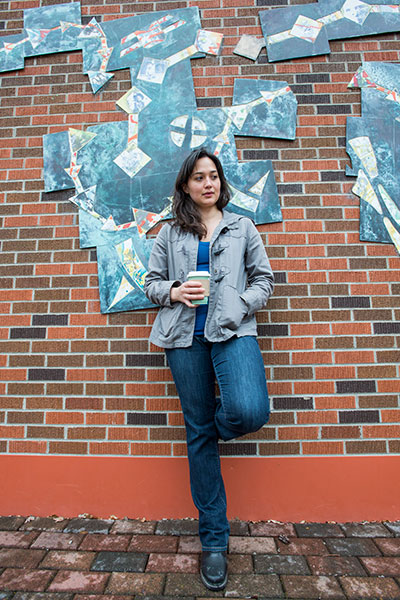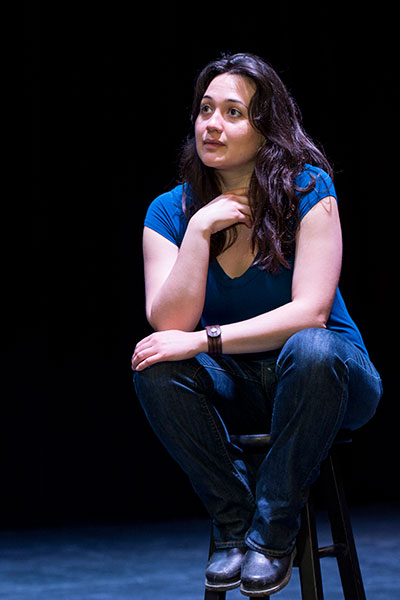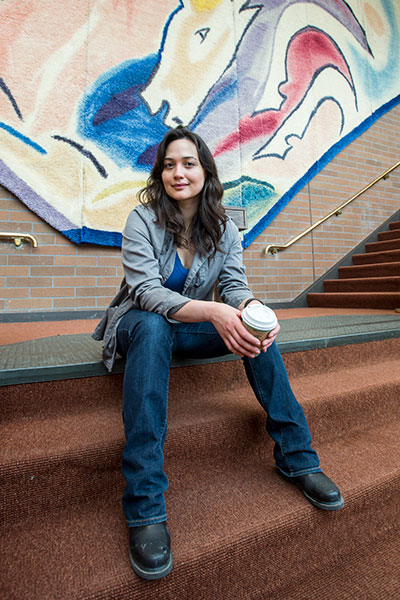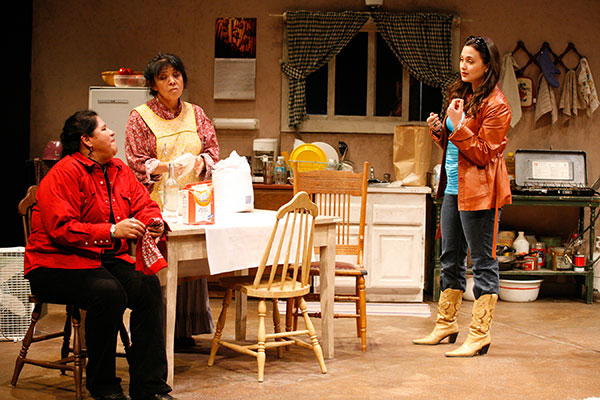- Editorial Offices
- 325 Brantly Hall
- Missoula, MT 59812
- (406) 243-2488
- themontanan@umontana.edu
- Icons By Maria Maldonado
Lily Gladstone is a star on the rise, but her Blackfeet identity and UM roots keep her grounded in the capricious world of showbiz
 Last February, Rene Haynes was standing in line at a Los Angeles Costco when her phone buzzed. She didn’t recognize the number, but as a Hollywood casting director, she’s used to urgent calls from strange numbers at all hours of the day. This one was from a fellow casting director, Mark Bennett. He was looking for Native actors to audition for a lead role in an independent film set in Montana.
Last February, Rene Haynes was standing in line at a Los Angeles Costco when her phone buzzed. She didn’t recognize the number, but as a Hollywood casting director, she’s used to urgent calls from strange numbers at all hours of the day. This one was from a fellow casting director, Mark Bennett. He was looking for Native actors to audition for a lead role in an independent film set in Montana.
The cashier scanned Haynes’ groceries as Bennett described the character—a reclusive ranch hand, the strong, silent type, grounded. Haynes, a UM theatre and dance alumna whose casting credits include Dances with Wolves, the Twilight series, and The Revenant, knew the perfect person. The conversation was over before she pushed her cart into the parking lot. She’d given Bennett only one name: Lily Gladstone, a relatively unknown young actor from Montana’s Blackfeet Reservation.
At the time, Gladstone was between acting jobs and wondering about her future. When her agent called, she quickly recognized the scale of the opportunity.
“It was a dream role,” she says. “I’ve always been drawn to quiet films, subtlety, what is not said. I couldn’t believe I was auditioning for it.”
She spent two weeks learning about the role. First she bought a pair of work boots and a flannel shirt. She wore them every day to get comfortable in her character’s wardrobe. She studied the script. Her character had broken bones, so she practiced moving with creaks. Finally, she drove to tiny Belfry, the town where the story was set. She wanted to feel her character’s landscape. After all that, two friends helped her film some scenes, which she sent to the director, Kelly Reichardt.
Three days later, she got the call: The role was hers. She screamed. She paced. She called her mother. And then, shortly thereafter, she spent almost six weeks on set near Livingston, acting across from Kristen Stewart in Certain Women, a feature film based on three short stories by Helena native Maile Meloy.
“It’s pretty revolutionary that part went to an almost total unknown and that it went to me, a Native actress, without it being a trope,” Gladstone says.
When Certain Women premiered at the Sundance Film Festival this January, Gladstone’s performance was singled out for praise. Rolling Stone heralded her a “breakout star” with “greater depths of feeling than many performers could ever hope to show.” A writer for Variety called her “luminous” and said a sustained close-up of Gladstone’s subtly expressive face was “the best single minute of acting this critic saw all festival.”
“It was really validating and exciting,” Gladstone says, “but something in there is terrifying. It’s a lot to live up to.”
For a future movie star, Gladstone had a suitably cinematic birth. Her parents lived on the Blackfeet Reservation, and when her mother went into labor early one August morning, no one was available at Indian Health Service in Browning to give her a caesarian. So an emergency helicopter flew her to Kalispell Regional Medical Center just as the sun crested the Rocky Mountain Front. Lily’s father told her she didn’t cry when she was born. She just looked around the room and smiled. It was her first audience.
Growing up as an ethnically mixed kid on the Blackfeet Reservation wasn’t always easy. Her father is Nez Perce and Blackfeet, and her mother is Dutch and Cajun. Because she was a light-skinned Native girl, Gladstone often found herself in an awkward middle ground between her Native and non-Native classmates. She shrugged off the teasing—mostly from mixed kids like her—and tried to make people laugh with her goofball antics in class.
“I had a lot of energy I didn’t know what to do with,” she says.
Gladstone found her outlet when the Missoula Children’s Theatre came to East Glacier to put on Cinderella. She was cast as one of the evil stepsisters.
“It was the first time that I felt cool,” she says. “I think I just loved attention.”
When she acquired a videotape of The Nutcracker ballet, she watched it every day, marveling over the dancing and drama. She started seriously pursuing ballet herself, first in the basement of a Browning church. Her parents encouraged her, their only child, even driving Gladstone to Columbia Falls for lessons.
Eventually, Gladstone’s family moved to Seattle, in part to give her more performance opportunities. Her mother got a teaching job as an early childhood specialist. Her father found work as a boilermaker in a shipyard. Gladstone joined a ballet troupe and honed her practice until age fifteen, when her passion became self-destructive. She developed an eating disorder. Her self-esteem plummeted.
“In ballet, you get so involved in perfectionism that you hate yourself and what you’re not able to do,” she says.
Gladstone fled ballet for theater, which restored her self-confidence and allowed her to use her body in different ways. She performed Shakespeare, contemporary drama, and fairy tales in high school productions and in a small community theater.
“As a teenager, I was someone who didn’t keep a lot of friends,” she says. “Theater and acting changed that. I loved being on stage.”

Gladstone enrolled at the University of Montana’s Davidson Honors College in 2004, where she was the first Native American to earn a prestigious Presidential Leadership Scholarship. She got her B.F.A. in acting, with a minor in Native American studies. And she performed every chance she got—in campus plays and in student films.
“There are a lot of talented kids at UM, but she’s always been a standout,” says Greg Johnson, who taught and directed her in Montana Repertory Theatre productions. “She’s absolutely a transcendent actress. We were lucky to have her.”
Johnson watched Gladstone transform from a “wide-eyed freshman” into a “thorough professional.” He says her focus, keen insight, and work ethic elevated her acting above her peers. She was punctual. When she got on set, she was usually “off-book,” meaning she’d memorized her lines. She instilled her characters with emotional depth. She paid attention and took notes.
As a longtime Broadway performer, Johnson knows that professional actors are beset with extreme highs and lows. Great achievement can be followed by spells of professional drought.
“Whether you’ve done fifty films or two films, you never know what tomorrow will bring,” he says. “You have to be strong of mind and spirit to succeed.”
But Johnson predicts a bright career for a grounded actor like Gladstone.
“I think she’s going to weather the slings and arrows of the profession very well,” he says. “She’s centered. She knows who she is.”
Gladstone graduated from UM in 2008 and went on a yearlong national tour with a Montana Rep production of To Kill a Mockingbird. She found work with a project called Living Voices, in which she traveled and performed one-woman plays about Native American boarding schools, Japanese internment camps, and migrant farmworkers.
Gladstone toured again with the Montana Rep for The Miracle Worker, in which she played Helen Keller’s mother. She wrote a play with a friend. And she directed children’s theater in Seattle with a group called Red Eagle Soaring.
She picked up local film work, too, first as an assistant for Montana filmmaking brothers Alex and Andrew Smith. The brothers were assembling a cast for their production of Winter in the Blood, the novel by Blackfeet author James Welch. Gladstone loved the book as a teenager. During the casting process, she read parts off-camera for hundreds of auditioning actors.
“We kept noticing no matter who we put in there, she was better,” says Andrew Smith. “We knew way before she did that we wanted her in the film.”
Eventually they cast Gladstone as Marlene, a woman who meets the main character just as his life is spiraling out of control. Smith says Gladstone worked hard to develop Marlene, while also contributing valuable cultural insight on the Blackfeet spiritual entities behind the other characters.
“She never stops thinking about the role,” says Smith, a professor in UM’s School of Media Arts. “I would like to put her in every film I make. She makes films better.”
Her success in Winter in the Blood soon led to other work. She played a minor speaking role opposite Oscar-winning star Benicio del Toro in Jimmy P. She acted in a short called Universal VIP and in a microbudget feature called Subterranea, which was made by UM media arts alumni.
But Smith says as a Native actor in an industry that is being skewered for its lack of diversity, Gladstone faces challenges other performers don’t.
“It’s more difficult if you’re an actor of color to get roles that are multidimensional,” Smith says, “because so few of those roles are written. But I think her talent will transcend the racial and ethnic pigeonholing. And as long as interesting roles get to her, she’ll have a damn good chance of getting them.”
"I think her talent will transcend the racial and ethnic pigeonholing. And as long as interesting roles get to her, she’ll have a damn good chance of getting them."
UM Professor Andrew Smith
Gladstone’s black hair, high cheeks, and transporting brown eyes are all products of her Native heritage. But her mixed genes lend Gladstone a look that many find hard to place.
“People see me and they know I’m something,” she says. “They think I’m Latina, or Japanese-American, but not Native American. We’re still a myth as a people.”
So Gladstone spends a lot of time explaining herself.
“Yes, I’m mixed,” she says. “Yes, I’m light. Yes, I’m Native.”
Her appearance is important, because it determines the roles she gets. Gladstone suspects she’s too fair to play a Native American in a historical movie like The Revenant. But she’s not fair enough to play the more plentiful roles written for white actors.
“That’s the industry,” she says. “It’s built around pigeonholing you based on appearance and type. You have to be confident in who you are. Otherwise it’s easy to get offended.”
To a casting director, Gladstone is “ethnically ambiguous,” meaning she could fit a variety of roles. And sometimes her characters reflect that ambiguity. In Certain Women, Gladstone’s character isn’t explicitly Native. Gladstone is proud of parts like these, because when Native actors play rounded, non-stereotypical roles, it helps demythologize the Native experience.
Independent movies are doing better at this than Hollywood. Gladstone says Native filmmakers Sydney Freeland and Nanobah Becker are telling modern Native stories, as is the sketch comedy group the 1491s. And she is encouraged by the success of Native actors like Q’orianka Kilcher and Chaske Spencer.
But when it comes to building a career as a professional actor, Gladstone is aware that being Native is a mixed bag.
“It helps and it hurts,” she says. “My identity has got me in the door for a lot of fantastic projects, but it’s not what ultimately landed me the role.”

On a recent Wednesday morning, I meet Gladstone in a café near campus. It’s unseasonably sunny, and she walks in wearing calf-length jeans, black Dr. Martens, a heather sweater, and a mustard-colored beanie.
She’s on time, and she holds the door for a stranger. Newfound fame hasn’t robbed her of any Montana decency. She’s confident, but considerate, too. She orders coffee and eggs.
Gladstone is twenty-nine years old. But at a time when many in her position would be fleeing for L.A. or New York, she just moved into a modest apartment near UM.
“I’m never going to fully leave Montana,” she says. “I like being in a place where I can work with Native communities. And Missoula’s a really nice place to be grounded when you’re a working, traveling artist.”
Gladstone did spend a week in L.A. during spring pilot season. She auditioned for sixteen roles, including a gypsy assassin, Nancy Drew, a lost millennial nanny, a hippy-dippy psychic who’s actually a witch, and a futuristic Marine sergeant on Mars. She’s waiting to hear back on some, but she’s not holding her breath.
“Sometimes you know you’re right for something,” she says. Other times, you’re just introducing yourself to a casting director.
It’s been four months since Sundance, enough time for the buzz to fade and questions to creep in about her future as an actor. She doesn’t have any definite acting work lined up. As for Certain Women, it won’t even hit theaters until the end of the year. Patience is part of the process.
“Even when you get something enormously exciting, it takes a long damn time,” Gladstone says. “It’s a lot of hoping and wishing. You have to learn to let go.”
Gladstone knows the phone could ring any minute, like it did with Certain Women. But in the meantime, she’s pursuing her own film ideas and working with kids. She’s helping produce a friend’s first feature. She thinks about grad school.
“I don’t know exactly what I’m going to do next,” she says, “but it’s going to be something unconventional.”
For now, Gladstone is heeding some advice from a former professor to never stop growing as a person, because character is the only thing with a shelf life in a business that can make you disposable.
“People want to work with good actors,” she says, “but they also want to work with good human beings.”
It bodes well for Hollywood and for the rest of us, then, that Gladstone is equally prepared for both of those roles.


Jacob Baynham graduated from UM with a journalism degree in 2007. He writes for Outside, National Parks, and other magazines. He lives in Missoula with his wife, Hilly McGahan ’07, and their two sons.